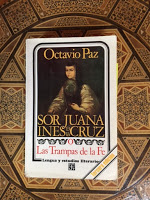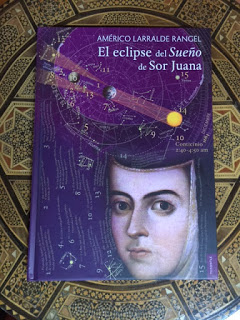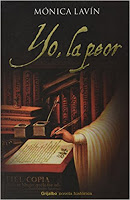
A most wonderful rare book about a 17th century American poet, whom I aim to write about, has arrived in my library. But phew, it STINKS. It stinks so nasty, I cannot even bear to read half a page of it.
Here’s what a used books expert says about smelly books:
But ayy, this book I have is another level of stinky. Think musty, as in New Orleans graveyard. Googling around, I find that baking soda, strong sunlight, and kitty litter are some possible remedies. I will try the kitty litter, and report. Meanwhile, any suggestions would be most welcome.
#
Migrating this blog, or rather, migrating selected link-updated posts from its old blogger platform to self-hosted WordPress here at www.madam-mayo.com has been a bit of a job, ongoing since January of this year 2019. So this Monday I’m taking a break, reposting a recently migrated piece, a readers’ favorite of this blog’s many Mexico-related posts.
What the Muse Sent Me about the Tenth Muse,
Sor Juana Inés de la Cruz
by C.M. Mayo
First published at Madam Mayo blog March 20, 2017

Late last year my amiga the brilliant short story writer Paula Whyman invited me to send a “Dispatch from Mexico City” for her new magazine, Scoundrel Time. So I dialed in to Muse HQ…
As I told Paula, woefully past the deadline, I had asked the Muse for a slider, a yummy little note about books in Mexico, but she delivered the whole ox. In other words, my “Dispatch from the Sister Republic or, Papelito Habla”is a novela-length essay about the Mexican literary landscape, from prehispanic codices to contemporary writers. It is what it is, I don’t want start chopping (there would be blood!!), but of course, a 30 page essay is too long for a magazine.
Scoundrel Time will be publishing an excerpt about Alvar Nuñez Cabeza de Vaca’s Relación-– a nearly 500 year-old memoir little known outside of Mexico and Texas, yet that stands as one of the most astonishing and important books ever written. (As soon that goes on-line, I will be sure to link to it from here. Read the piece about Cabeza de Vaca in Scoundrel Time here.)
As for my full-length essay, “Dispatch from the Sister Republic,” look for it as a Kindle under my own imprint, Dancing Chiva, ASAP. it is now available in Kindle.
Herewith my other favorite excerpt, about the Tenth Muse, Sor Juana Inés de la Cruz:
Excerpt from
“DISPATCH FROM THE SISTER REPUBLIC OR, PAPELITO HABLA”
by C.M. MAYO
For rare book collectors, Mecca is Mexico City’s Colonia Centro, and for such aficionados of mexicana as myself, its sanctum sanctorum, the Librería Madero—by the way, recently relocated from the Avenida Madero to the Avenida Isabela La Católica, facing the the formidable wedding cake-white corner of the 16th century ex-convent of San Jerónimo, known today as the Claustro de Sor Juana, that is, the Convent of Sister Juana.
And if you would not know Sor Juana from a poinsettia, gentle reader, with all respect, you must crowbar out that boulder of ignorance, for which you will be rewarded by a glimpse of the diamond of the Mexico’s Baroque period, the first great Latin American poet and playwright, “the Tenth Muse,” a cloistered nun.
Texan poet John Campion was the first to translate Sor Juana’s magnum opus, “Primero sueño,” as “The Dream,” in 1983. (Alas, that date is not a typo.) Campion’s translation is out of print, but he offers a free PDF download of the text on his website, worldatuningfork.com. The first lines of Campion’s translation beautifully capture Sor Juana’s uncanny power:
Pyramidal
death-born shadow of earth
aimed at heaven
a proud point of vain obelisks
pretending to scale the Stars

In her time Sor Juana was one of the most learned individuals, man or woman, in the New World, and her prodigious oeuvre, from love poems to polemics, comedies to enigmas to plays to villancicos, was exceptionally sophisticated, so much so that its interpretation is today the province of a small army of sorjuanistas. As Mexico’s Nobel laureate poet Octavio Paz writes in Sor Juana: Or, the Traps of Faith (translated by Margaret Sayers Peden), “A work survives its readers; after a hundred or two hundred years it is read by new readers who impose on it new modes of reading and interpretation. The work survives because of these interpretations, which are in fact resurrections.”

And perchance startling discoveries. In his 2011 El eclipse del Sueño de Sor Juana, Américo Larralde Rangel makes a radiant case that her “Primero Sueño” describes the dawn over Mexico City after a lunar eclipse on the solstice of the winter of 1684.
In the Librería Madero I find on the first shelf, facing out, two new books by sorjuanistas: one about Sor Juana’s family, another, just published by a Legionario de Cristo, that purports to decipher her twenty enigmas. The latter work incorporates a series of contemporary paintings of Sor Juana in the baroque style—dim backgrounds, crowns and scepters of flowers, and afloat above her head, fat-tummied cherubs, flounces, unspooling bundles of draperies. But these Sor Juanas look too pert, make too coy a tilt of the head. It seems to me as if, session over, the model might have just tossed off that habit to wriggle into some yoga wear.
Yes, just as in the United States, in Mexican cities yoga studios have been popping up like honguitos.

But if a vision of modern Mexico would have been obscure to Sor Juana, by no means is Sor Juana obscure in modern Mexico. She has inspired scores of poets and musicians; there have been movies, documentaries, and novels, most recently, Mónica Lavin’s 2009 best-seller Yo, la peor (I, the Worst—yet to be translated into English—fingers crossed that Patricia Dubrava will do it).
As I write this in 2017, Sor Juana graces the celadon-green 200 peso bill. From the portrait by Miguel Cabrera in the Museo Nacional de Historia: a serenely intelligent young woman’s face framed in a wimple, and behind her, her quills and inkpot and an open book of her poetry—and a few lines:
Hombres necios que acusáis
a la mujer sin razón,
sin ver que sois la ocasión
de lo mismo que culpáis.
I cannot pretend to render the music of Sor Juana’s lines into English. But here’s a rough go at their literal meaning: You pig-headed men who accuse women unjustly, blind to the fact that you are the cause for that which you cast blame.
[…. CONTINUE READING]

UPDATE: “Dispatch from the Sister Republic or, Papelito Habla,” my long essay on the Mexican literary landscape and the power of the book, is now available in Kindle.
#
P.S. You will find more Mexico-related posts on this blog’s Mexico page. As you will see, there are a few posts that have been migrated, and many more to go– and more as yet unlisted. Plus, ayyy, there is the whole Maximilian – Carlota blog (History of Mexico’s Second Empire / French Intervention) to do…. It will happen.

Luis Felipe Lomelí Interviews Yours Truly About Mexico: A Traveler’s Literary Companion, & Etc.
José N. Iturriaga’s Mexico In US Eyes (México en las miradas de Estados Unidos)
Visit my website for more about my books, articles, and podcasts.

